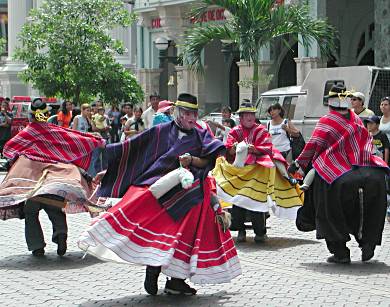Login form
Customs of Ecuador
Marriage and Family
 When a girl reaches age 15, a Catholic ceremony officially presents her to society. If the family can afford it, a party with food, drinks, and dancing follows the ceremony. Women usually marry by age 23, and as young as 14 in some rural areas, while men marry around age 25. Families often emphasize that young people should complete their education before marrying. Many urban couples do not live together before their church wedding, even if they have already been married by law. Common-law relationships, referred to as estilo manabita, are usual in rural, coastal areas, largely because people cannot afford the expense of a formal wedding. They are accepted as legal marriages, even though no ceremony has been performed.
When a girl reaches age 15, a Catholic ceremony officially presents her to society. If the family can afford it, a party with food, drinks, and dancing follows the ceremony. Women usually marry by age 23, and as young as 14 in some rural areas, while men marry around age 25. Families often emphasize that young people should complete their education before marrying. Many urban couples do not live together before their church wedding, even if they have already been married by law. Common-law relationships, referred to as estilo manabita, are usual in rural, coastal areas, largely because people cannot afford the expense of a formal wedding. They are accepted as legal marriages, even though no ceremony has been performed.
Elderly members of the family are respected, and several generations may live under the same roof. Many families lead a simple life in small homes or rented apartments. While traditional roles are followed in most families, urban families are changing as more women work outside the home and more men share household duties. Other traditions are changing as well. For example, children used to live with their parents until they got married, but now they often leave to get an education, to work, or simply to be independent. A young woman would traditionally go directly from her parents’ home to her husband’s, but more women are experiencing independence before marriage. Families are also getting smaller, particularly in urban areas.
Eating
Serranos—people from the mountainous areas—generally favor maize and potatoes, while many Costeños—people from the coastal regions—favor rice, beans, and bananas. Fresh fruit is abundant, and fish is a staple item. Soup is almost always served at both the midday and evening meals. Hot bread is a popular afternoon snack. Some favorite dishes include arroz con pollo (rice with chicken), locro (a soup made with potatoes, cheese, meat, and avocados), llapingachos (cheese and potato cakes), ceviche (raw seafood marinated in lime and served with onions, tomatoes, and various spices), fritada (fried pork), and empanadas (pastries filled with meat or cheese).
Food and eating habits are an important part of Ecuadorian culture. Every holiday is associated with a special kind of food, and every town has a specialty dish. The main meal is usually in the middle of the day. Mealtimes are considered a good time for conversation—catching up, conducting business, or socializing. When inviting a guest to a restaurant, the host expects to pay for the meal. Young people, however, will often split a bill.
Socializing
A handshake is usual when greeting someone. Close friends sometimes “kiss the air” with their lips lightly brushing or touching each other’s cheeks. Men often embrace if well acquainted. It is customary to address people by a title, such as Señor or Señora, when being introduced. First names are not generally used between those who are not well acquainted. Among friends, the title Don or Doña, followed by the first name, indicates both respect and friendship. Common greetings include ¡Buenos días! (“Good day”) or ¿Cómo está? (“How are you?”). Friends commonly greet each other with ¡Hola! (“Hello”).
When Ecuadorians visit, it is usually for a meal and conversation. However, unannounced visits are common and welcomed. Guests are typically offered something to drink, and it is polite to accept. Guests are not expected to arrive on time, and may be from ten minutes to an hour late, depending on the event. Guests invited for dinner do not leave right after the meal, but stay for conversation. When guests leave the home, they are often given a small gift of something the family has on hand, such as fruit or candy. Evening social gatherings—for birthdays, reunions, or parties—might extend past midnight, especially on the coast. These usually involve eating, dancing, and drinking.
At small gatherings, it is polite for guests to greet each person individually and say goodbye to everyone individually. Among young Ecuadorians, more formal customs are being replaced by informal ones. For instance, young people often use group greetings rather than personal ones.
Recreation
Fútbol (soccer) is the favorite sport in
Holidays and Celebrations
Ecuadorians celebrate the new year by burning effigies of the old year in the streets on New Year’s Eve (31 December). Carnaval takes place in February or March. Easter, Labor Day (1 May), and The Battle of Pichincha (24 May), which marks
The independence of
Source: Encarta Interactive World Atlas

